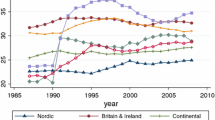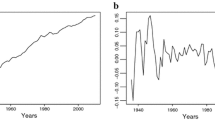Abstract
We investigate the relationship between mortality rates and income per capita in Mexico. We employ a state-level panel approach and analyze overall and disaggregated age-adjusted mortality rates. The use of a fixed-effect estimator allows us to reduce potential bias from unobserved effects that may be present in cross-sectional studies of multiple countries. We do not find a statistically significant relationship between the overall mortality rate and income per capita. However, there is significant variation in the relationship for mortality categories and subcategories. Our results may provide insight into the mechanisms that drive the relationship between mortality and income.









Similar content being viewed by others
References
Aaby, P. 1992a. Lessons for the Past: Third World Evidence and the Reinterpretation of Developed World Mortality Declines. Health Transition Review: Historical Epidemiology and the Health Transition, 2 (Supplement): 155–184.
Aaby, P. 1992b. Overcrowding and Intensive Exposure: Major Determinants of Variations in Measles Mortality in Africa. in Mortality and Society in Sub-Saharan Africa, edited by Etiene van de Walle, Gilles Pison, and Mpembele Sala-Diakanda. New York: Oxford University Press, 317–348.
Abala, C., F. Vio, J. Kain, and R. Uauy . 2002. Nutrition Transition in Chile: Determinants and Consequence. Public Health Nutrition, 5 (1A): 123–128.
Ahmad, O., C. Boschi-Pinto, A.D. Lopez, C.J.L. Murray, R. Lozano, and M. Inoue . 2001. Age Standardization of Rates: A New WHO Standard. GPE Discussion Paper Series, 31, EIP/GPE/EBD. Geneva, Switzerland: World Health Organization.
Baird, S., J. Friedman, and N. Schady . 2011. Aggregate Income Shocks and Infant Mortality in the Developing Word. The Review of Economic and Statistics, 93 (3): 847–856.
Blakely, T., I. Kawachi, J. Atkison, and J. Fawcett . 2004. Income and Mortality: The Shape of the Association and Confounding New Zealand Census-Mortality Study 1981–1999. International Journal of Epidemiology, 33 (4): 874–883.
Brook, R., B. Franklin, W. Cascio, Y. Hong, G. Howard, M. Lipsett, R. Luepker, M. Mittleman, J. Samet, S. Smith, and I. Tager . 2004. Air Pollution and Cardiovascular Disease: A Statement for Healthcare Professionals from the Expert Panel on Population and Prevention Science of the American Heart Association. American Heart Association Scientific Statement. Circulation, 109: 2655–2671.
Co, C.Y., F. Kong, and S. Lin . 2008. Pollution across Chinese Provinces. Indian Council for Research on International Economic Relations, Working Paper No. 223.
Consejo Nacional de Poblacion (CONAPO). 2011. Indicadores Demograficos Basicos. Secretaria de Gobernacion, Distrito Federal, Mexico.
Colgrove, J. 2002. The McKeown Thesis: A Historical Controversy and Its Enduring Influence. American Journal of Public Health, 92 (5): 725–729.
Cutler, D., A. Deaton, and A. Lleras-Muney . 2006. The Determinants of Mortality. Journal of Economic Perspectives, 20 (3): 97–120.
Cutler, D., A. Lleras-Muney, and T. Vogl . 2008. Socioeconomic Status and Health: Dimensions and Mechanisms. NBER Working Paper No. 14333. Cambridge: National Bureau of Economic Research.
Deaton, A. 2004. Health in an Age of Globalization. NBER Working Paper No. 10669. Cambridge: National Bureau of Economic Research.
Deaton, A. 2006. Global Patterns of Income and Health: Facts, Interpretations and Policies. NBER Working Paper No. 12735. Cambridge: National Bureau of Economic Research.
Dominici, F., A. McDermott, S. Zeger, and J. Samet . 2003. Airborne Particulate Matter and Mortality: Timescale Effects in Four US Cities. American Journal of Epidemiology, 157 (12): 1055–1065.
Ferreira, J., and N. Schady . 2009. Aggregate Economic Shocks, Child, Schooling and Child Health. The World Bank Research Observer. International Bank for Reconstruction and Development, 24 (2): 1–35.
Filmer, D., and L. Pritchett . 1999. The Impact of Public Spending on Health: Does Money Matter? Social Science and Medicine, 49 (10): 1309–1323.
Georgiadis, G., J. Pineda, and F. Rodriguez . 2010. Has the Preston Curve Broken Down? Human Development Research, Paper 2010/32, Human Development Reports. United Nations: United Nations Development Programme.
HEI. 2001. Particulate Air Pollution and Daily Mortality: Analyses of the Effects of Weather and Multiple Air Pollutants. The Phase I.B Report of the Particle Epidemiology Evaluation Project. Cambridge: Health Effects Institute.
Instituto Nacional de Ecologia (INE). 2007. Tercer almanaque de datos y tendencias de la calidad del aire en nueve ciudades Mexicanas. Distrito Federal, Mexico.
Instituto Nacional de Estadistica Geografia e Informatica (INEGI). 2010a. Encuesta nacional de empleo y seguridad social 2009. Aguascalientes, Mexico.
Instituto Nacional de Estadistica Geografia e Informatica (INEGI). 2010b. Banco de informacion economica. Aguascalientes, Mexico.
International Monetary Fund (IMF). 2010. World Economic Outlook Database. Available at http://www.imf.org/external/pubs/ft/weo/2011/01/weodata/index.aspx, accessed 20 November 2012.
Jack, W., and M. Lewis . 2009. Health Investments and Economic Growth: Macroeconomic Evidence and Microeconomic Foundations. Policy Research Working Paper No. 4877. Washington: The World Bank.
List, J., and C. Gallet . 1999. The Environmental Kuznets Curve: Does One Size Fit All? Ecological Economics, 31 (3): 409–423.
Mathers, C., D. Fat, M. Inoue, C. Rao, and A. Lopez . 2005. Counting the Dead and What They Died from: An Assessment of the Global Status of Cause of Death Data. Bulletin of the World Health Organization, 83 (3): 171–177.
McCall, M. 1985. Environmental and Agricultural Impacts of Tanzania’s Villagization Programme, in Population and Development in Africa, edited by John Innes Clarke, Mustafa Khogali, and Leszek A. Kosinski. Cambridge, MA: University Press, 123–140.
McKeown, T. 1976. The Modern Rise of Population. New York: Academic Press.
Millimet, D., J. List, and T. Stengos . 2003. The Environmental Kuznets Curve: Real Progress or Misspecified Models? The Review of Economics and Statistics, 85 (4): 1038–1047.
Narayan, P.K., and S. Narayan . 2010. Carbon Dioxide Emissionsand Economic Growth: Panel Data Evidence from Developing Countries. Energy Policy, 38 (1): 661–666.
Pieters, N., M. Plusquin, B. Cox, M. Kicinski, J. Vangronsveld, and T. Nawrot . 2012. An Epidemiological Appraisal of the Association between Heart Rate Variability and Particulate Air Pollution: A Meta-analysis. Heart, 98 (15): 1127–1135.
Popkin, B.M. 1999. Urbanization, Lifestyle Changes and the Nutrition Transition. World Development, 27 (11): 1905–1916.
Popkin, B.M. 2008. Will China’s Nutrition Transition Overwhelm Its Health Care System and Slow Economic Growth? Health Affairs, 27 (4): 1064–1076.
Preston, S. 1975. The Changing Relation between Mortality and Level of Economic Development. Population Studies, 29 (2): 231–248.
Pritchett, L., and L. Summers . 1993. Wealthier is Healthier. Background Paper for World Development Report, WPS 1150. Washington: The World Bank.
Rivera, J.A., S. Barquera, F. Campirano, I. Campos, M. Sadfie, and V. Tovar . 2002. Epidemiological and Nutritional Transition in Mexico: Rapid Increase of Non-communicable Chronic Diseases and Obesity. Public Health Nutrition, 5 (1A): 113–122.
Rivera, J.A., S. Barquera, T. Gonzalez-Cossio, G. Olaiz, and J. Sepulveda . 2004. Nutrition Transition in Mexico and Other Latin American countries. Nutrition Review, 62 (S2): S149–S157.
Romeiu, I., J. Samet, K. Smith, and N. Bruce 2002. Outdoor air pollution and acute respiratory infections among children in developing countries. Journal of Occupational and Environmental Medicine, 44 (7): 640–649.
Root, G. 1997. Population and Spatial Differentials in Child Mortality in Zimbabwe. Social Science and Medicine, 44 (3): 413–421.
Secretaria de Salud (SSA). 2001–2006. Salud: Mexico, informacion para la rendicion de cuentas. Distrito Federal, Mexico.
Secretaria de Salud (SSA). 2004. Encuesta Nacional de Evaluacion del Desempeno de los Sistemas de Salud. Distrito Federal, Mexico.
Secretaria de Salud (SSA). 2006. Encuesta Nacional de Salud y Nutricion 2006. Distrito Federal, Mexico.
Secretaria de Salud (SSA). 2007–2009. Rendicion de cuentas. Distrito Federal, Mexico.
Secretaria de Salud (SSA). 2009. Poblacion (proyecciones 1990–2012). Direccion General de Informacion en Salud. Distrito Federal, Mexico.
Secretaria de Salud (SSA). 2010. Estadisticas de Mortalidad. Distrito Federal, Mexico.
Snyder, S., and W. Evans . 2006. The Effect of Income on Mortality: Evidence from the Social Security Notch. The Review of Economic and Statistics, 88 (3): 482–495.
Soares, R. 2007. On the Determinants of Mortality Reduction in the Developing World. Population and Development Review, 33 (2): 257–287.
Stevens, G., R. Dias, K. Thomas, J. Rivera, N. Carvalho, S. Barquera, K. Hill, and M. Ezzati . 2008. Characterizing the Epidemiological Transition in Mexico: National and Subnational Burden of Diseases, Injuries, and Risk Factors. Plos Medicine, 5 (6): 900–910.
van Ginneken, J.K., and A.W. Teunisson . 1992. Morbidity and Mortality from Diarrhoeal Diseases in Children under Age Five in Sub-Saharan Africa, in Mortality and Society in Sub-Saharan Africa, edited by Etiene van de Walle, Gilles Pison and Mpembele Sala-Diakanda . Oxford, UK: Clarendon Press.
World Health Organization (WHO). 2008. The Global Burden of Disease: 2004 Update. Geneva, Switzerland: WHO Press.
World Health Organization and Food and Agriculture Organization of the United Nations (WHO/FAO). 2003. Expert Consultation on Diet, Nutrition, and the Prevention of Chronic Diseases. Report of the Joint WHO/FAO Expert Consultation. Geneva.
Author information
Authors and Affiliations
Appendix
Appendix
Rights and permissions
About this article
Cite this article
Gonzalez, F., Quast, T. Non-Linearities in the Relationship between Aggregate Income and Mortality Rates. Eastern Econ J 41, 51–69 (2015). https://doi.org/10.1057/eej.2013.36
Published:
Issue Date:
DOI: https://doi.org/10.1057/eej.2013.36




